
In December 2017, I was diagnosed with Coeliac Disease, which meant cutting out all gluten from my diet.
It came as quite a shock at the time as I didn’t have the typical stomach problems (often diarrhoea, nausea and bloating) which tend to come with coeliac disease.
While doing blood tests to try to get to the bottom of some of my pain issues, my doctor discovered that I had several nutritional deficiencies. She needed to find out why, so had to do more blood tests. One gave a positive reading for coeliac disease.
However, the blood test alone isn’t enough to diagnose. She said that I would need to have an endoscopy and that I shouldn’t go gluten-free until that was carried out. Gluten must be eaten for at least six weeks prior to the endoscopy to give an accurate result.
I worried about the endoscopy, but it was a relatively painless and fast procedure for me. A tube with a camera went down my throat, into my stomach and then some samples of my stomach lining were taken. A couple of weeks later, it was confirmed that I did have coeliac disease and I would have to cut out all gluten from my diet.
I very quickly had to learn that it was going to be a life-long condition. But I always like to look for positives, and there was one. A big one. Coeliac disease is a manageable condition. No drugs, no treatment – just a change in diet.
What is coeliac disease?
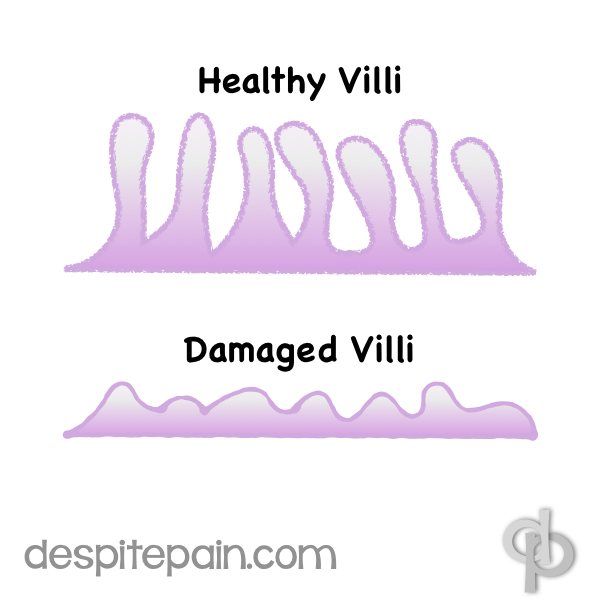
Coeliac disease is an autoimmune condition. The immune system reacts when gluten is eaten. The stomach is lined with villi which are like little fingers that reach out and grab the nutrients from food. They help the body to absorb those nutrients. But when a person has coeliac disease, the villi become badly damaged when gluten is eaten. The villi become flattened and unable to absorb the nutrients, resulting in people being ill and becoming deficient in vitamins and minerals.
Silent Coeliac
I was a ‘silent coeliac’, which meant that I had no stomach symptoms to make a doctor consider coeliac sooner. But this had meant that I had unknowingly been living with it and suffering from malabsorption issues for a long time. Quite a few things fell into place after my diagnosis. Some of my health issues such as nerve pain, fatigue and osteoporosis are possibly related to that.
Since cutting out gluten, I’m no longer a silent coeliac. If I accidentally eat gluten, I know very quickly. My dietician explained that my villi were recovering and enjoying their new gluten free environment. Now, if they get the slightest hint of gluten, they like to let me know they’re not happy.
Which foods contain gluten?
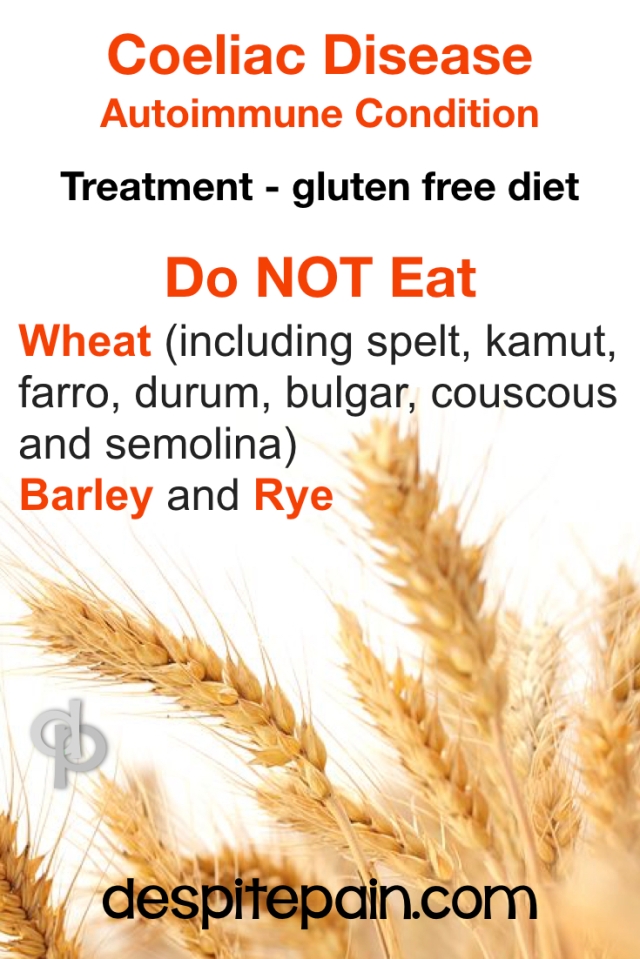
The gluten culprits are wheat, barley and rye, and they can be found in many foods. Label reading is imperative.
I had always eaten gluten as I’d had no reason not to. I had never had any reason to check food labels.
And suddenly, I had to educate myself about what I could and couldn’t eat.
“Cut out gluten,” sounds easy. It sounds simple.
Unfortunately, it’s not.
It actually means not being able to eat a crumb of bread. Not even a tiny grain of flour. It means that I need to check every label on food. I can’t eat something which says ‘may contain traces of gluten’, because even a trace of it could make me ill.
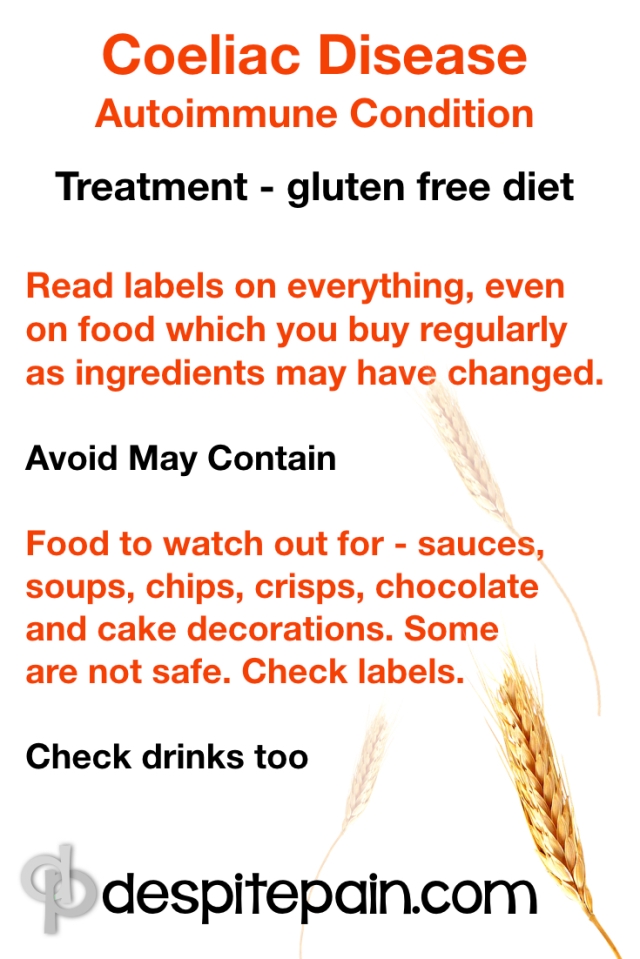
Grocery shopping was daunting at first. Reading glasses had to be at the ready to read all the labels. Then there was disappointment if something had to be put back on the shelf. Gluten appears in more food that people realise. Even my favourite Cadbury’s Dairy Milk chocolate has a gluten warning.
So many foods need to be avoided. The obvious are breads, pasta, cakes and biscuits. Less obvious are some soups, sauces, crisps and even some drinks. Food from the cold counter or delicatessen are often problematic. Even if they don’t contain gluten, they might be sliced using a knife or slicing machine which had previously been used on something which does. Or the server might have just picked up some gluten containing food, then contaminated the ‘safe’ food.
When restaurants and cafés have anything gluten free on their menus, they tend to have maybe two or three options at most. But at the bottom of the menu, there is normally a disclaimer to tell customers that although it’s gluten free, they cannot guarantee that there’s no cross-contamination. I can understand why they need to do this. The cross-contamination issue is difficult enough in my own kitchen.
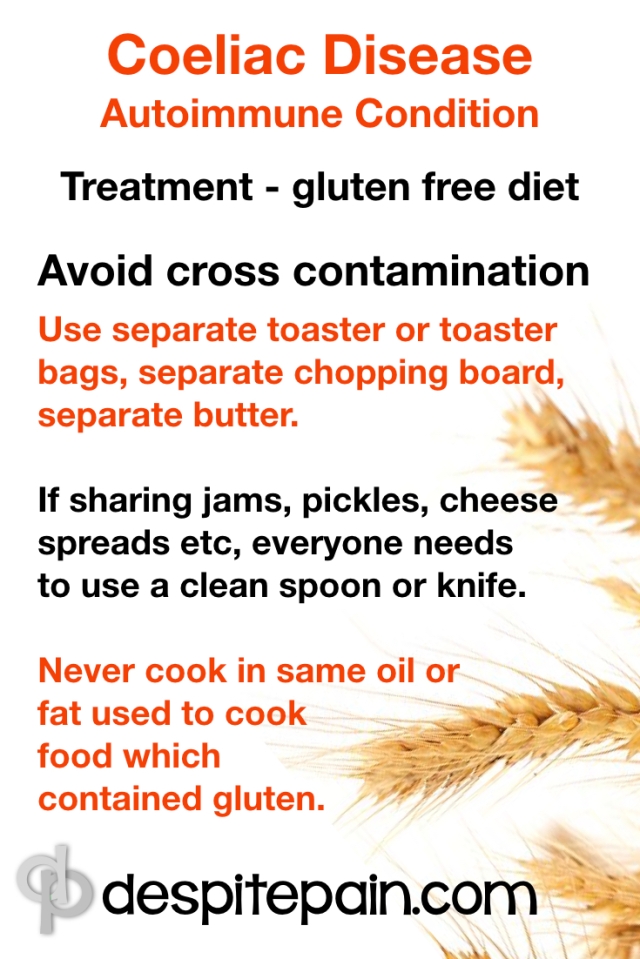
Cross contamination is a serious issue. A crumb, one single crumb, from my husband’s toast can make me ill. Even using the same butter knife is enough to ‘gluten’ me. I have my own toaster in the kitchen, my own butter and my own jam. Food in the fridge has labels with my name so there’s no confusion.
That probably sounds like an overreaction…but it’s not. That’s the deal with coeliac disease.
Which foods do not contain gluten?
There is plenty of food which coeliacs can eat. Food like fresh meat, eggs, fruit and vegetables are naturally gluten-free. Lots of “normal” foods are safe – you just need to check the labels to be sure. Supermarkets do have a reasonable amount of gluten-free bread, pasta and flour. They even have biscuits and cakes and many of them are actually enjoyable.
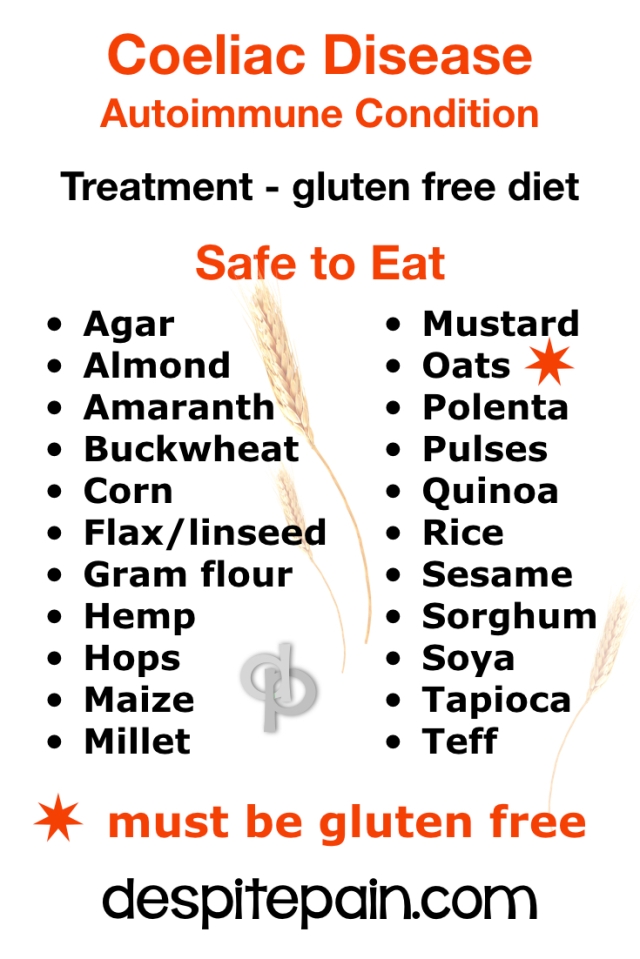
There was, and still is, elation when I discover that something is gluten-free – especially when it involves chocolate. I think I punched the air in Tesco a few days ago when I saw that tins of Quality Street were safe.
No cure and no treatment for coeliac disease
There is no cure and no medical treatment for coeliac disease.
However, the damage done to the villi can be repaired simply by eating no gluten. Once repaired, it will start absorbing those nutrients again.
Coeliac disease is a serious autoimmune condition. If the diet isn’t changed, conditions such as chronic fatigue, neuropathy, osteoporosis and stomach cancer can develop.
Coeliac disease sounds daunting. Overwhelming. In the beginning, it was. But now, it’s become a way of life.
Help and awareness for coeliac disease
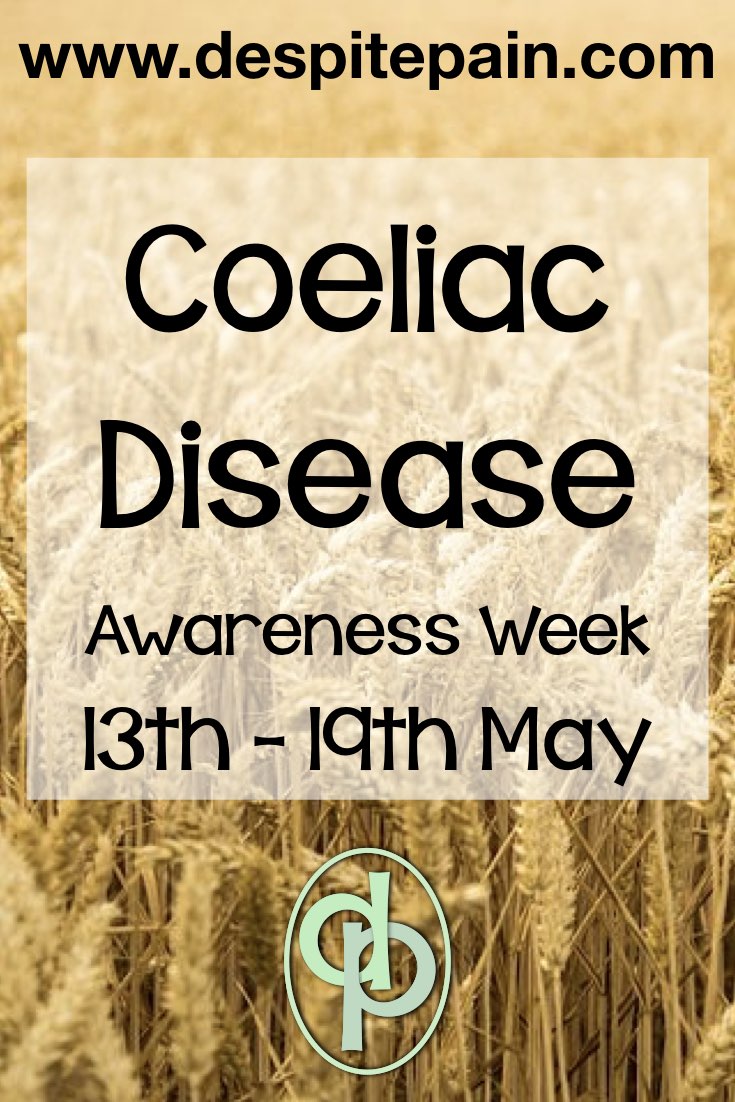
To anyone newly diagnosed, I’d suggest, first of all, take some deep breaths. Then start learning. The Coeliac UK site is a great place to begin. Once you’ve had an official diagnosis after an endoscopy, don’t put off going gluten-free. The sooner you do, the sooner those little villi can start repairing.
Coeliac Awareness Week in the UK is the 13th – 19th of May.
I’d be really grateful if you could share my post to help spread awareness.
Do you have coeliac disease? What was the hardest part for you? Or have you been newly diagnosed? What’s your biggest fear?
Please leave a comment below.
And please do click on the social media share buttons.
Thank you for reading.
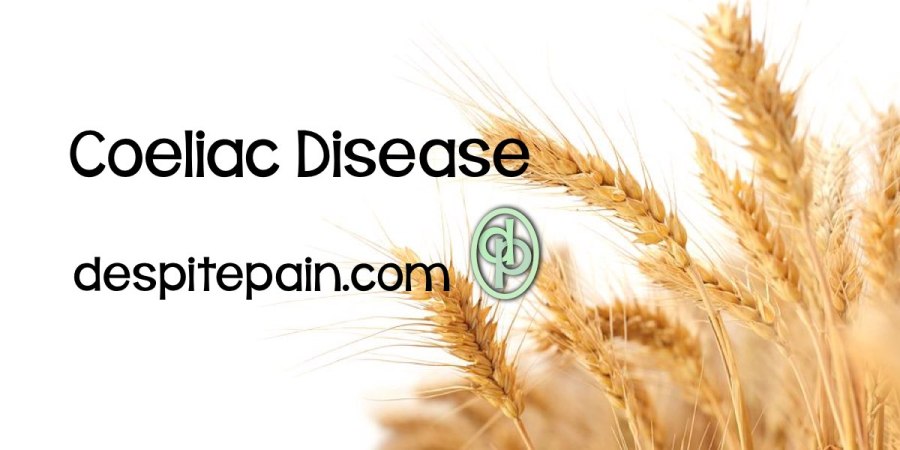

This is such a clear and informative explanation of coeliac disease.
LikeLike
Thanks, Trish.
LikeLike
Thanks for this, it’s really helpful! My son has just been diagnosed aged 6. We usually eat out a fair bit as a family and now I’m scared to go anywhere and to trust that what he is putting in his mouth, outside our house, is safe 😦
LikeLike
So sorry about your son, Laurie. When you go out to a restaurant, explain to them how careful they need to be. Don’t just say he needs gluten free. Tell them it’s coeliac disease, it normally helps them to realise it’s not just a dietary choice.
Once you get your head around it, it won’t seem so bad, and your little boy will soon understand too. There are lots of treats and snacks which are safe, so he won’t need to feel like he’s missing out.
LikeLike
Hello there! I’m extremely grateful that you have learned how to manage your disease and have been able to keep yourself so well regulated. I recently (only about a year ago as well) was diagnosed with SCD (Severe Crohn’s Disease). It’s been a long, bumpy road, with IBS (Irritable Bowel Syndrome) and RA (Rheumatoid Arthritis) being thrown on top of things. Like yours, they’re all life-long chronic diseases that cannot be cured. But, also like yours, they can be managed. It takes a little more than a simple change in diet, but medication does just fine. My biggest fear is that maybe one day that medication just won’t be enough. But hopefully that’s not the case. Stay strong, and don’t let this new diagnosis control you. 🙂
LikeLike
Pingback: The Liebster Award 2018 – Despite Pain
Hi there, thanks for reading and leaving a comment. I remember my first visit to the dietician after being diagnosed. We talked about other conditions like yours, and I said I was grateful that mine is controlled by diet. I’m on enough medication for other problems, so to have a ‘disease’ which was solely controllable by diet, felt like a good thing. I hope that your medication always controls it – remember that there are scientist always working on new meds and cures. So stay hopeful always.
LikeLike
Thank you! very informative. Grocery shopping in the US, if you have food issues is nearly impossible. I find I must stick to preparing all my food from scratch from certified organic ingredients, and I avoid all grains, except rice on rare occasions. The industry puts grain products in almost everything!
LikeLike
Melanie, I remember being shocked during my first grocery shopping trip. I checked every label and gluten always seemed to be there. It’s in the most unlikely of foods. It really is pretty difficult to shop. We cook mostly from scratch, so can manage fine, but it must be so difficult for people who rely on ready prepared food.
LikeLike
Brave and informative post. I learned a lot about the challenges you face from this post.
LikeLike
Thanks for reading and commenting. It is pretty challenging at times but it’s doable.
LikeLiked by 1 person
I think I have it too 🙊 I havent got tested myself yet. Because I am scared! But from a few days I am on a wheat free diet. So just checking myself. As here in india we all eat roti (made from wheat) in our meal with vegetables.
LikeLiked by 2 people
Hi Snehal,
I hope you don’t have it, but really, if you do, it’s not so bad. It just takes time to get used to it.
Be careful about cutting out wheat before getting tested. You need to be eating gluten for at least six weeks before tests are done to give an accurate result.
LikeLike
Pingback: 20 Ways to Try to Distract Yourself From Pain – Despite Pain
Pingback: Disability Blogger Award by Chronillicles – Despite Pain
I have Celiac. A restaurant glutened me last month. My food should have been gluten free. I was sick for three days.
LikeLiked by 1 person
I’m so sorry that you were glutened. I hope you let the restaurant know. If they advertise gluten-free food, they should do as much as possible to avoide cross-contamination. Also, when asking for food in a restaurant, I’d suggest telling them you have coeliac disease, rather than just asking for something from the gluten-free menu. This may make them take more care. Hope you’re feeling better now.
LikeLike
There are lots of people who have chosen a gluten-free diet, and it’s lovely for them when restaurants offer a few gluten-free choices for them. But for those with celiac disease, they need to accept that cross-contamination cannot be avoided in a restaurant kitchen or a friend’s kitchen. Though I make gluten-free foods for my GF (non-celiac) friends, I would NEVER offer my gluten-free foods to a person with celiac because of the cross-contamination issue. Even if the restaurant takes “more care” if you mention the celiac disease, there WILL be unavoidable cross-contamination. If I had celiac, I would simply not eat in restaurants. When the tiniest particle of gluten has such serious consequences, it simply isn’t worth it.
LikeLike
I have quite a few friends who suffer from Coeliac disease. Many who never knew they had an issue other than stomach discomfort. I’ve heard a lot of why there are so many cases of Coeliac disease nowadays and watched a few documentaries that explained how the production of wheat has changed so much through engineering that the wheat isn’t what it used to be and many people can’t digest it well. Not sure how true that is but a few have said this theory. I know the friends I had who suffer feel 100 times better once they eliminate gluten. Luckily everyone is catering to gluten-free now including supermarkets and restaurants.
LikeLiked by 1 person
I hadn’t heard of that before, Scott, but there must be a reason why so many people are being diagnosed.
LikeLike
My daughter has lived with gluten intolerance for the last 10 years, I was so surprised by the number of people that thought that it was a made up disease or that she would just snap out of it, there is a lot of ignorance around this issue.
LikeLiked by 1 person
I’m sorry about your daughter. You’re right about ignorance. Many people think we’re on a fad diet, and mock it. They don’t realise it’s an actual illness.
LikeLike
I can imagine this was difficult to deal with at first since so many things have gluten in them! Hopefully things have become easier now and better to manage.
LikeLiked by 1 person
It was pretty difficult in the beginning, but yes, I’m more used to it now, and manage ok. Thank you.
LikeLike
Very informative! It is manageable which is a good thing. However it will not be easy especially during the starting period. There are so many dishes with hidden gluten! For example in some restaurants they add some flour in tomato soup.
I am happy you now know the root of your issues with health. I am sure your life will become so much better!
LikeLiked by 1 person
Yes, there is gluten hidden in so much food. It makes grocery shopping a major event.
LikeLike
Feel sad for the little boy. May God give him and you the strength to fight it out.This post is also so informative about this disease I had no idea about.
LikeLiked by 1 person
I always feel bad for young children with any health condition. Although coeliac is manageable by diet, it must be so difficult for children when they can’t eat the same as their friends.
LikeLike
I have a friend who was recently diagnosed in her 50s – like you she was “silent”! I have definitely seen a difference to my gut issues since cutting out gluten (my coeliac result came back negative but I had been GF for 6 months by the time I had the endoscopy!) and a few other things. This is a really informative article, Liz! Great read, C xxx
LikeLiked by 1 person
Thanks Claire. Coeliac UK believe there are many more people out there who are coeliac but undiagnosed. If you’re already gluten free, you’d need to eat gluten for six weeks prior to testing. People don’t want to do that, and I don’t blame them. I wouldn’t want to start eating it again.
LikeLiked by 1 person
Woah, that sounds tough but I am glad it is a manageable condition. I can imagine only consuming gluten-free foods can be a hassle.
LikeLiked by 1 person
I’m actually just getting to read about this disease in full. Life is full of up and downs and we should always be thankful for the gift of today.
Peace be with you all round.
LikeLiked by 1 person
It took me a minute to realize that coeliac and celiac disease were the same. I have family members who have celiac. I did not realize how serious cross-contamination was. I’ve been happy to see so many new gluten-free options available, especially at restaurants.
LikeLike
It took me a minute to realize that coeliac and celiac disease were the same. I have family members who have celiac. I did not realize how serious cross-contamination was. I’ve been happy to see so many new gluten-free options available, especially at restaurants.
LikeLike
One of my friends has that and told me she gets annoyed when people claim to have it just because they think gluten is bad for them and don’t WANT to eat it. Thanks for being so informative I learned a lot
LikeLike
This is a really nice, informative and clear post. Thanks for sharing your story.
LikeLike
It is nice to know if your positive approach to your new lifestyle as a way to cope with your ailment. This truly does help in raising awareness.
LikeLike
I have to admit, I thought this was just a dietary fad for quite a while, and so many people treated gluten-free like a buzz word. But it’s legit, and can cause serious health issues. My husband has a friend who’s daughter is so allergic that they have a specially trained dog who has to sniff everything this child eats beforehand to make sure it’s ok, and alerts them if it isn’t. I wish more people would read your writing and understand it better. You explained it very clearly.
LikeLike
Pingback: How to Find Out What Triggers or Worsens Pain – Despite Pain
Pingback: Searching For a Diagnosis: Chasing the Cure – Despite Pain